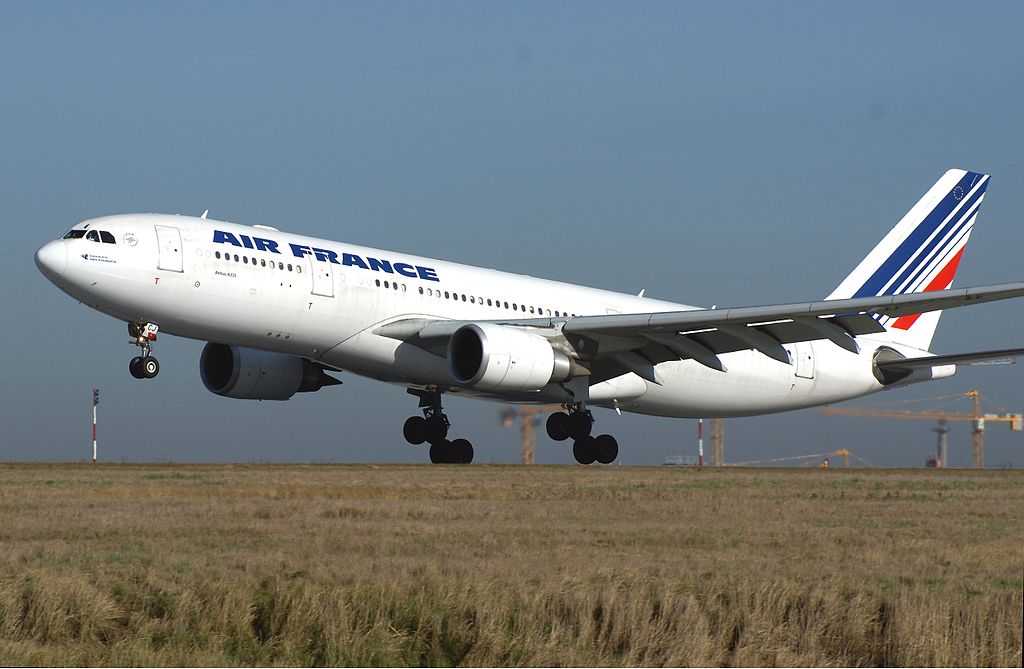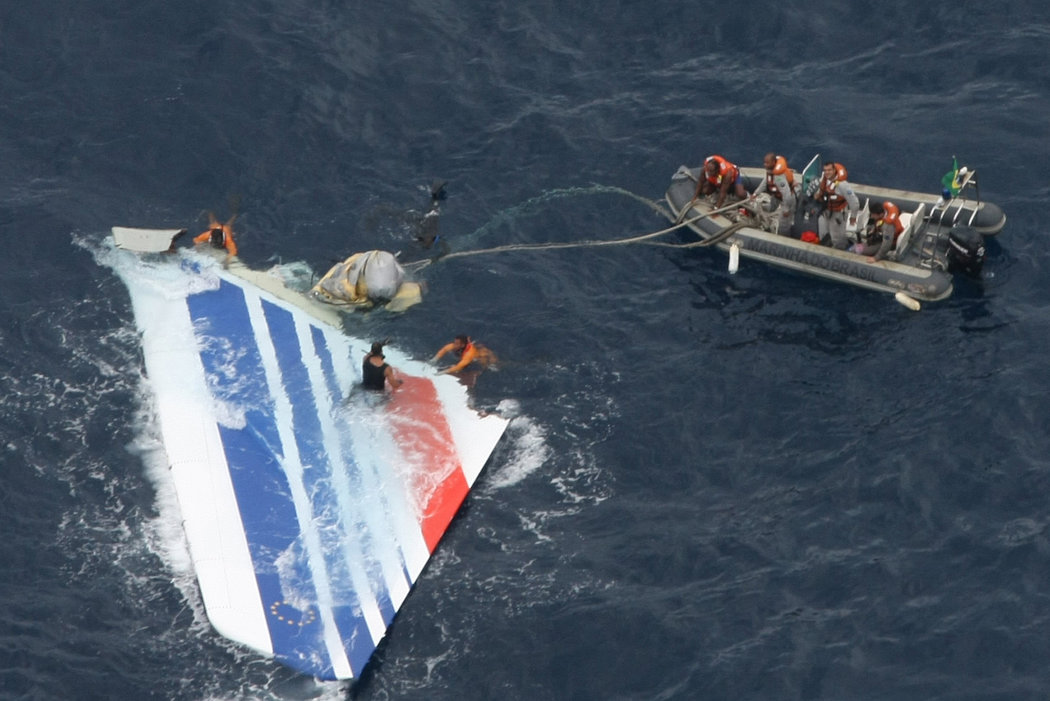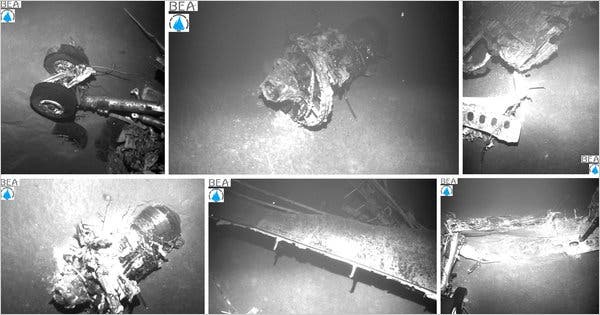01 June 2009 - Air France 447
The aircraft departed from Rio de Janeiro-Galeão International Airport on 31 May 2009 at 19:29 local time (22:29 UTC), with a scheduled arrival at Paris-Charles de Gaulle Airport at 10:03 the following day. The last verbal contact with the aircraft was at 01:35 UTC, 3 hours and 6 minutes after the 22:29 UTC departure, when it reported that it had passed waypoint INTOL, located 565 km (351 mi) off Natal, on Brazil's north-eastern coast. The aircraft left Brazilian Atlantic radar surveillance at 01:49 UTC.

The Airbus A330 is designed to be flown by a crew of two pilots. However, because the thirteen hours "duty time" (flight duration, plus pre-flight preparation) for the Rio–Paris route exceeds the maximum ten hours permitted by Air France's procedures, Flight 447 was crewed by three pilots: a captain and two first officers. With three pilots on board, each of them can take a rest during the flight, and for this purpose the A330 has a rest cabin, situated just behind the cockpit.
In accordance with common practice, the captain had sent one of the co-pilots for the first rest period with the intention of taking the second break himself. At 01:55 UTC, he woke the second pilot and said: "... he's going to take my place". After having attended the briefing between the two co-pilots, the captain left the cockpit to rest at 02:01:46 UTC. At 02:06 UTC, the pilot warned the cabin crew that they were about to enter an area of turbulence. It is probably two-three minutes after this that the airplane encountered icing conditions (the CVR recorded what sounded like hail or graupel on the outside of the airplane, and the engine anti-ice system came on) and ice crystals started to accumulate in the pitot tubes. The pilots turned the aircraft slightly to the left and decreased its speed from Mach 0.82 to Mach 0.8 (the recommended "turbulence penetration speed").
At 02:10:05 UTC the autopilot disengaged and the airplane transitioned from normal law to alternate law 2. The engines' auto-thrust systems disengaged three seconds later. Without the auto-pilot, the aircraft started to roll to the right due to turbulence, and the pilot reacted by deflecting his side-stick to the left. One consequence of the change to alternate law was an increase in the aircraft's sensitivity to roll, and the pilot's input over-corrected for the initial upset. During the next thirty seconds, the aircraft rolled alternately left and right as the pilot adjusted to the altered handling characteristics of his aircraft. At the same time he made an abrupt nose-up input on the side-stick, an action that was unnecessary and excessive under the circumstances. The aircraft's stall warning sounded briefly twice due to the angle of attack tolerance being exceeded, and the aircraft's recorded airspeed dropped sharply from 274 knots to 52 knots. The aircraft's angle of attack increased, and the aircraft started to climb. By the time the pilot had control of the aircraft's roll, it was climbing at nearly 7,000 ft/min (for comparison, typical normal rate of climb for modern airliners is only 2,000–3,000 ft/min at sea level, and much smaller at high altitude).
At 02:10:34, after displaying incorrectly for half a minute, the left-side instruments recorded a sharp rise in airspeed to 215 knots, as did the Integrated Standby Instrument System (ISIS) another half a minute later (the right-side instruments are not recorded by the recorder). The icing event had lasted for just over a minute. The pilot continued making nose-up inputs. The trimmable horizontal stabilizer (THS) moved from three to thirteen degrees nose-up in about one minute, and remained in that latter position until the end of the flight.
At 02:11:10 UTC, the aircraft had climbed to its maximum altitude of around 38,000 feet. There, its angle of attack was 16 degrees, and the engine thrust levers were in the fully forward Takeoff/Go-around detent (TOGA), and at 02:11:15 UTC the pitch attitude was slightly over 16 degrees and falling, but the angle of attack rapidly increased towards 30 degrees. A second consequence of the reconfiguration into alternate law was that "stall protection" no longer operated. Whereas in normal law, the airplane's flight management computers would have acted to prevent such a high angle of attack, in alternate law this did not happen. (Indeed, the switch into alternate law occurred precisely because the computers, denied reliable speed data, were no longer able to provide such protection – nor many of the other functions expected of normal law). The wings lost lift and the aircraft stalled.
At 02:11:40 UTC, the captain re-entered the cockpit. The angle of attack had then reached 40 degrees, and the aircraft had descended to 35,000 feet with the engines running at almost 100% N1 (the rotational speed of the front intake fan, which delivers most of a turbofan engine's thrust). The stall warnings stopped, as all airspeed indications were now considered invalid by the aircraft's computer due to the high angle of attack. In other words, the aircraft was oriented nose-up but descending steeply. Roughly 20 seconds later, at 02:12 UTC, the pilot decreased the aircraft's pitch slightly, air speed indications became valid and the stall warning sounded again and sounded intermittently for the remaining duration of the flight, but stopped when the pilot increased the aircraft's nose-up pitch. From there until the end of the flight, the angle of attack never dropped below 35 degrees. From the time the aircraft stalled until it impacted with the ocean, the engines were primarily developing either 100% N1 or TOGA thrust, though they were briefly spooled down to about 50% N1 on two occasions. The engines always responded to commands and were developing in excess of 100% N1 when the flight ended.

The flight data recordings stopped at 02:14:28 UTC, or 3 hours 45 minutes after takeoff. At that point, the aircraft's ground speed was 107 knots, and it was descending at 10,912 feet per minute (108 knots of vertical speed). Its pitch was 16.2 degrees (nose up), with a roll angle of 5.3 degrees left. During its descent, the aircraft had turned more than 180 degrees to the right to a compass heading of 270 degrees. The aircraft remained stalled during its entire 3 minute 30 second descent from 38,000 feet before it hit the ocean surface at a speed of 152 knots (280 km/h), comprising vertical and horizontal components of 108 and 107 knots respectively. The aircraft broke up on impact; everyone on board died, presumably instantaneously.
>> Download the full CVR transcript as published by the BEA <<
Below is an abbreviated and more explained part of the crucial moments.
Marc Dubois – Captain
Pierre-Cédric Bonin – Copilot
David Robert – Copilot
FA – Flight Attendant
Translated from French
[comments added by Popular Mechanics article]
02:03:44 (Bonin) The inter-tropical convergence… look, we’re in it, between ‘Salpu’ and ‘Tasil.’ And then, look, we’re right in it…
02:05:55 (Robert) Yes, let’s call them in the back, to let them know…
02:05:59 (FA) Yes? Marilyn.
02:06:04 (Bonin) Yes, Marilyn, it’s Pierre up front… Listen, in 2 minutes, we’re going to be getting into an area where things are going to be moving around a little bit more than now. You’ll want to take care.
02:06:13 (FA) Okay, we should sit down then?
02:06:15 (Bonin) Well, I think that’s not a bad idea. Give your friends a heads-up.
02:06:18 (FA) Yeah, okay, I’ll tell the others in the back. Thanks a lot.
02:06:19 (Bonin) I’ll call you back as soon as we’re out of it. 02:06:20 (FA) Okay.
02:06:50 (Bonin) Let’s go for the anti-icing system. It’s better than nothing.
[Because they are flying through clouds, the pilots turn on the anti-icing system to try to keep ice off the flight surfaces; ice reduces the plane's aerodynamic efficiency, weighs it down, and in extreme cases, can cause it to crash.]
02:07:00 (Bonin) We seem to be at the end of the cloud layer, it might be okay.
02:08:03 (Robert) You can possibly pull it a little to the left.
02:08:05 (Bonin) You can possibly pull it a little to the left. We’re agreed that we’re in manual, yeah?
[An alarm sounds for 2.2 seconds, indicating that the autopilot is disconnecting. The cause is the fact that the plane's pitot tubes, externally mounted sensors that determine air speed, have iced over, so the human pilots will now have to fly the plane by hand. Aside from the loss of airspeed indication, everything is working fine. Neither Bonin nor Roberts has ever received training in how to deal with an unreliable airspeed indicator at cruise altitude, or in flying the airplane by hand under such conditions.
02:10:06 (Bonin) I have the controls.
02:10:07 (Robert) Okay.
[Perhaps spooked by everything that has unfolded over the past few minutes—the turbulence, the strange electrical phenomena, his colleague's failure to route around the potentially dangerous storm—Bonin reacts irrationally. He pulls back on the side stick to put the airplane into a steep climb. Almost as soon as Bonin pulls up into a climb, the plane's computer reacts. A warning chime alerts the cockpit to the fact that they are leaving their programmed altitude. Then the stall warning sounds. This is a synthesized human voice that repeatedly calls out, "Stall!" in English, followed by a loud and intentionally annoying sound called a "cricket."]
02:10:07 (Robert) What’s this?
02:10:15 (Bonin) There’s no good… there’s no good speed indication.
02:10:16 (Robert) We’ve lost the, the, the speeds, then?
[The plane is soon climbing at a blistering rate of 7000 feet per minute. While it is gaining altitude, it is losing speed, until it is crawling along at only 93 knots, a speed more typical of a small Cessna than an airliner. Robert notices Bonin's error and tries to correct him.]
02:10:27 (Robert) Pay attention to your speed. Pay attention to your speed.
02:10:28 (Bonin) Okay, okay, I’m descending.
02:10:30 (Robert Stabilize.
02:10:31 (Bonin) Yeah.
02:10:31 (Robert) Descend… It says we’re going up… It says we’re going up, so descend.
02:10:36 (Robert) Descend!
02:10:37 (Bonin) Here we go, we’re descending.
02:10:38 (Robert) Gently!
[Bonin eases the back pressure on the stick, and the plane gains speed as its climb becomes more shallow. It accelerates to 223 knots. The stall warning falls silent. For a moment, the co-pilots are in control of the airplane.]
02:10:41(Bonin) We’re… yeah, we’re in a climb.
02:10:49 (Robert) Damn it, where is he?
02:10:55 (Robert) Damn it!
[Another of the pitot tubes begins to function once more. The cockpit's avionics are now all functioning normally. The flight crew has all the information that they need to fly safely, and all the systems are fully functional. The problems that occur from this point forward are entirely due to human error.]
02:11:03 (Bonin) I’m in TOGA, huh?
[Bonin's statement here offers a crucial window onto his reasoning. TOGA is an acronym for Take Off, Go Around. When a plane is taking off or aborting a landing—"going around"—it must gain both speed and altitude as efficiently as possible. At this critical phase of flight, pilots are trained to increase engine speed to the TOGA level and raise the nose to a certain pitch angle. Clearly, here Bonin is trying to achieve the same effect: He wants to increase speed and to climb away from danger. But he is not at sea level; he is in the far thinner air of 37,500 feet. The engines generate less thrust here, and the wings generate less lift. Raising the nose to a certain angle of pitch does not result in the same angle of climb, but far less. Indeed, it can—and will—result in a descent.]
02:11:06 (Robert) Damn it, is he coming or not?
[The plane now reaches its maximum altitude. With engines at full power, the nose pitched upward at an angle of 18 degrees, it moves horizontally for an instant and then begins to sink back toward the ocean. ]
02:11:21 (Robert) We still have the engines! What the hell is happening? I don’t understand what’s happening.
[Robert has no idea that, despite their conversation about descending, Bonin has continued to pull back on the side stick. The men are utterly failing to engage in an important process known as crew resource management, or CRM. They are failing, essentially, to cooperate. It is not clear to either one of them who is responsible for what, and who is doing what. This is a natural result of having two co-pilots flying the plane. "When you have a captain and a first officer in the cockpit, it's clear who's in charge. The vertical speed toward the ocean accelerates. If Bonin were to let go of the controls, the nose would fall and the plane would regain forward speed. But because he is holding the stick all the way back, the nose remains high and the plane has barely enough forward speed for the controls to be effective. As turbulence continues to buffet the plane, it is nearly impossible to keep the wings level. ]
02:11:32 (Bonin) Damn it, I don’t have control of the plane, I don’t have control of the plane at all!
02:11:37 (Robert) Left seat taking control!
[At last, the more senior of the pilots (and the one who seems to have a somewhat better grasp of the situation) now takes control of the airplane. Unfortunately, he, too, seems unaware of the fact that the plane is now stalled, and pulls back on the stick as well. Although the plane's nose is pitched up, it is descending at a 40-degree angle. The stall warning continues to sound. At any rate, Bonin soon after takes back the controls.
A minute and a half after the crisis began, the captain returns to the cockpit. The stall warning continues to blare. ]
02:11:43 (Captain) What the hell are you doing?
02:11:45 (Bonin) We’ve lost control of the plane!
02:11:47 (Robert) We’ve totally lost control of the plane. We don’t understand at all… We’ve tried everything.
[By now the plane has returned to its initial altitude but is falling fast. With its nose pitched 15 degrees up, and a forward speed of 100 knots, it is descending at a rate of 10,000 feet per minute, at an angle of 41.5 degrees. It will maintain this attitude with little variation all the way to the sea. Though the pitot tubes are now fully functional, the forward airspeed is so low—below 60 knots—that the angle-of-attack inputs are no longer accepted as valid, and the stall-warning horn temporarily stops. This may give the pilots the impression that their situation is improving, when in fact it signals just the reverse.
[The captain of the flight makes no attempt to physically take control of the airplane. Had Dubois done so, he almost certainly would have understood, as a pilot with many hours flying light airplanes, the insanity of pulling back on the controls while stalled. But instead, he takes a seat behind the other two pilots.]
02:12:14 (Robert) What do you think? What do you think? What should we do?
[As the stall warning continues to blare, the three pilots discuss the situation with no hint of understanding the nature of their problem. No one mentions the word "stall." As the plane is buffeted by turbulence, the captain urges Bonin to level the wings—advice that does nothing to address their main problem. The men briefly discuss, incredibly, whether they are in fact climbing or descending, before agreeing that they are indeed descending. As the plane approaches 10,000 feet, Robert tries to take back the controls, and pushes forward on the stick, but the plane is in "dual input" mode, and so the system averages his inputs with those of Bonin, who continues to pull back. The nose remains high.
02:13:40 (Robert) Climb... climb... climb... climb...
02:13:40 (Bonin) But I've had the stick back the whole time!
[At last, Bonin tells the others the crucial fact whose import he has so grievously failed to understand himself.]
02:13:42 (Captain) No, no, no… Don’t climb… no, no.
02:13:43 (Robert) Descend, then… Give me the controls… Give me the controls!
[Bonin yields the controls, and Robert finally puts the nose down. The plane begins to regain speed. But it is still descending at a precipitous angle. As they near 2000 feet, the aircraft's sensors detect the fast-approaching surface and trigger a new alarm. There is no time left to build up speed by pushing the plane's nose forward into a dive. At any rate, without warning his colleagues, Bonin once again takes back the controls and pulls his side stick all the way back.]
02:14:23 (Robert) Damn it, we’re going to crash… This can’t be happening!
02:14:25 (Bonin) But what’s happening?
02:14:27 (Captain) Ten degrees of pitch…
Exactly 1.4 seconds later, the cockpit voice recorder stops.


